Museum of the Origins of Man
HUMAN HEADS MIXED WITH ANIMAL HEADS
IN POST-PALEOLITHIC SCULPTURE
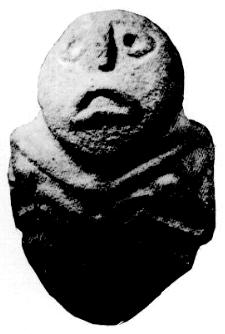
Fig. 6A1) Zooanthropomorphic stone sculpture representing an artistic man-animal hybrid. Archaeologists who have done research in the discovery area consider him a "fish man", and this attribution probably refers to resemblance of his lips with those of freshwater fish. It was produced in the Mesolithic by a fishing population along the Danube River.
The typology of this sculpture is attributable to the anthropomorphic and zooanthropomorphic stone sculpture of the Paleolithic, in every component, and in particular for the upward gaze, and for the absence of ears.
Sculptures "equal" to this have been found in the area, so it can be considered an " idol" in all respects, akin to the stele-statues of Lunigiana or the statues on Easter Island, and so on.
Height: 20 inches approx.
Origin: Lepenski Vir, Serbia.
Material culture: Mesolithic.
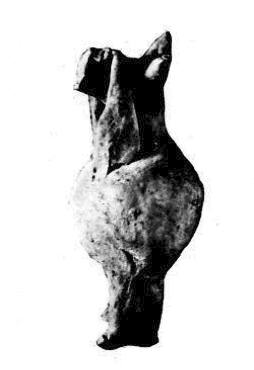 Fig. 6A2) Zooanthropomorphic terracotta sculpture representing an artistic man-animal hybrid who covers his eyes with his hands, and this undoubtedly had a meaning in worship. It is the art of the first urban civilizations.
Fig. 6A2) Zooanthropomorphic terracotta sculpture representing an artistic man-animal hybrid who covers his eyes with his hands, and this undoubtedly had a meaning in worship. It is the art of the first urban civilizations.
Size: small.
Origin: Mohenjo-daro, Indian subcontinent.
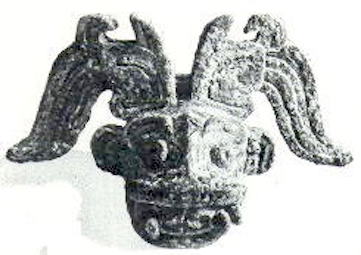 Fig. 6A3) Zooanthropomorphic bronze sculpture. This small sculpture depicts an artistic man-animal hybrid in a particularly elaborate style of that time. The features of the animal are the horns, ears and mouth.
Fig. 6A3) Zooanthropomorphic bronze sculpture. This small sculpture depicts an artistic man-animal hybrid in a particularly elaborate style of that time. The features of the animal are the horns, ears and mouth.
Size: 2.6 inches.
Origin: China.
Period: IX-VIII centuries BC.
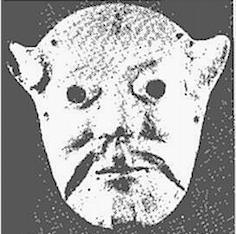 Fig. 6A4) Zooanthropomorphic terracotta sculpture representing an artistic man-animal hybrid; the face is human, the ears are animal. It is a mask used for cult rites.
Fig. 6A4) Zooanthropomorphic terracotta sculpture representing an artistic man-animal hybrid; the face is human, the ears are animal. It is a mask used for cult rites.
Phoenician art.
Sant'Antioco, Sardinia.
 Fig. 6A5) Zooanthropomorphic wooden sculpture representing an artistic man-animal hybrid. The head is human; the teeth are both human and animal; the tongue is animal. The style is between geometric and caricatural. It is an "ancestral pole" called a Butugur.
Fig. 6A5) Zooanthropomorphic wooden sculpture representing an artistic man-animal hybrid. The head is human; the teeth are both human and animal; the tongue is animal. The style is between geometric and caricatural. It is an "ancestral pole" called a Butugur.
The sculpture is in black wood.
Height: 6.5 feet.
Origin: Southeastern Borneo.
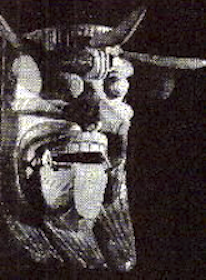 Fig. 6A6) Zooanthropomorphic wooden sculpture. It represents an artistic man-animal hybrid. The teeth are human and animal; the tongue is animal. The style deforms the face, which is almost invented to obtain the horrendous expression. It is a mask used for Indian worship rites.
Fig. 6A6) Zooanthropomorphic wooden sculpture. It represents an artistic man-animal hybrid. The teeth are human and animal; the tongue is animal. The style deforms the face, which is almost invented to obtain the horrendous expression. It is a mask used for Indian worship rites.
Origin: Guatemala.
BR>
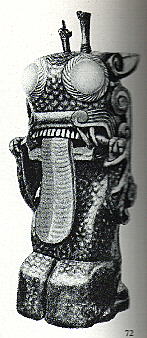 Fig. 6A7) Zooanthropomorphic wooden sculpture representing an artistic man-animal hybrid who is kneeling. The style deforms the whole figure, which is largely invented, to obtain the horrible expression, which however is extremely elegant. This liking of horror, which has very evident religious roots, unites the art of certain periods of Far East Asia with the art of Central and South America.
Fig. 6A7) Zooanthropomorphic wooden sculpture representing an artistic man-animal hybrid who is kneeling. The style deforms the whole figure, which is largely invented, to obtain the horrible expression, which however is extremely elegant. This liking of horror, which has very evident religious roots, unites the art of certain periods of Far East Asia with the art of Central and South America.
Height: 4.6 feet.
Origin: Hsin Yang, Honan, China.
Dating: 3rd century BC.
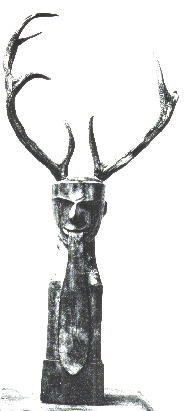 Fig. 6A8) Zooanthropomorphic wooden sculpture representing an artistic man-animal hybrid. The face is human; the enormous tongue and horns are animal. The horns are of a deer.
Fig. 6A8) Zooanthropomorphic wooden sculpture representing an artistic man-animal hybrid. The face is human; the enormous tongue and horns are animal. The horns are of a deer.
Height cm 82.
Origin: Ch'ang Sha, Hunan, China.
Dating: 3rd-2nd century BC.
Location: British Museum, London.
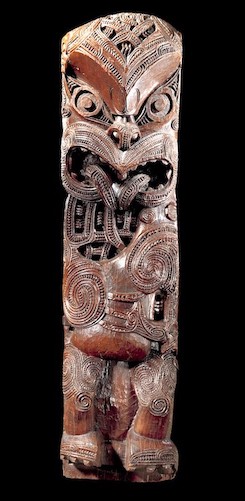 Fig. 6A9) Zooanthropomorphic wooden sculpture representing an artistic man-animal hybrid. The stylistic language is one of the most complex known, as it blends together the zooanthropomorphic representation, which is largely invented, to decoration.
Fig. 6A9) Zooanthropomorphic wooden sculpture representing an artistic man-animal hybrid. The stylistic language is one of the most complex known, as it blends together the zooanthropomorphic representation, which is largely invented, to decoration.
Sculpture from a meeting house, representing an ancestor or an ancient warrior, or a mythological being.
Size: height 43 inches; width 10.9 inches; thickness 5 inches.
Origin: Te Awara, New Zealand (Oceania).
Museum of Primitive Art, transferred to Metropolitan Museum of Art, New York
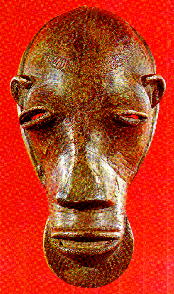 Fig. 6A10) Zooanthropomorphic wooden sculpture representing the head of an artistic man-animal hybrid. It can be said that this sculpture is the "true type" of artistic man-animal hybrid, as every character of the head, both human and animal, are truly fused together. Unlike the sculpture from New Zealand (Fig. 6A9) it has no decoration.
Fig. 6A10) Zooanthropomorphic wooden sculpture representing the head of an artistic man-animal hybrid. It can be said that this sculpture is the "true type" of artistic man-animal hybrid, as every character of the head, both human and animal, are truly fused together. Unlike the sculpture from New Zealand (Fig. 6A9) it has no decoration.
It is a "commemorative" mask used for cult rituals.
Origin: Bron, Ghana.
Museum of Primitive Art, transferred to Metropolitan Museum of Art, New York
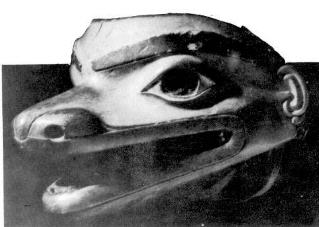 Fig. 6A11) Zooanthropomorphic wooden sculpture representing an artistic man-animal hybrid, in this case a seal. It is colored in red, green and black. It is a dance mask for use in cult rituals.
Fig. 6A11) Zooanthropomorphic wooden sculpture representing an artistic man-animal hybrid, in this case a seal. It is colored in red, green and black. It is a dance mask for use in cult rituals.
Origin: North America.
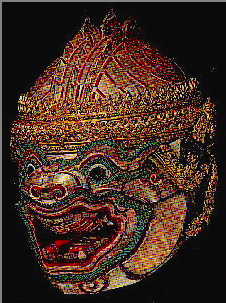 Fig. 6A12) Zooanthropomorphic wooden sculpture representing an artistic man-animal hybrid. It is a theater mask with religious origins and traditions. It is very colorful and the stylistic language of the shape blends with the decoration.
Fig. 6A12) Zooanthropomorphic wooden sculpture representing an artistic man-animal hybrid. It is a theater mask with religious origins and traditions. It is very colorful and the stylistic language of the shape blends with the decoration.
Origin: Thailand.
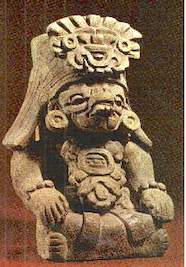 Fig. 6A13) Zooanthropomorphic terracotta sculpture representing an artistic man-animal hybrid. He is seated, and his face has mixed features of man and animal. He wears a headdress with a human face made in an almost geometric and imaginative style, and on the chest he has another human face. These two faces certainly have their own symbolic meaning and are not just two decorations.
Fig. 6A13) Zooanthropomorphic terracotta sculpture representing an artistic man-animal hybrid. He is seated, and his face has mixed features of man and animal. He wears a headdress with a human face made in an almost geometric and imaginative style, and on the chest he has another human face. These two faces certainly have their own symbolic meaning and are not just two decorations.
It represents "sitting Cocijo, god of lightning".
Height: 7.5 inches.
Origin: Monte Alban, Mexico.
Dating: 400-600 AD.
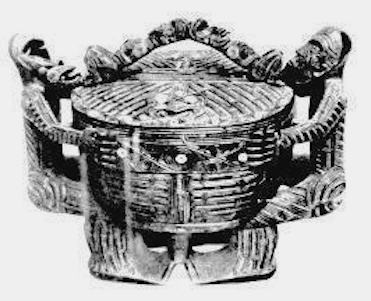 Fig. 6A14) Zooanthropomorphic wooden sculpture. Applied art. It is a wooden cup that has two handles consisting of a man and an artistic man-animal hybrid. The lid has a handle consisting of a man and a man-animal hybrid. The decoration is intense.
Fig. 6A14) Zooanthropomorphic wooden sculpture. Applied art. It is a wooden cup that has two handles consisting of a man and an artistic man-animal hybrid. The lid has a handle consisting of a man and a man-animal hybrid. The decoration is intense.
The connection to religion is evident even in everyday objects.
Maori art.
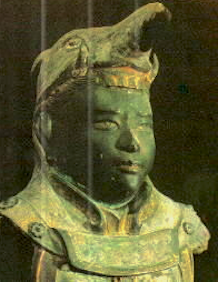 Fig. 6A15) Anthropomorphic bronze sculpture (detail) representing Gubujo, one of the eight guardians of the Buddha statue. He has a headdress made up of an animal head. He represents a minor deity.
Fig. 6A15) Anthropomorphic bronze sculpture (detail) representing Gubujo, one of the eight guardians of the Buddha statue. He has a headdress made up of an animal head. He represents a minor deity.
Origin: Kofuku - Ji in Nara, Japan.
Nara period.
Dating: 734 AD.
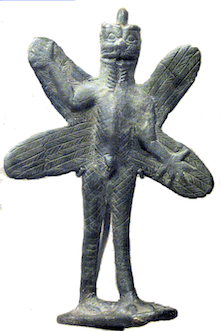 Fig. 6A16) Zooanthropomorphic bronze sculpture representing an artistic man-animal hybrid. The workmanship of the sculpture is coarse. The human figure is proportionate; the features of the animal are of different types: the legs are of a raptor; the wings seem feathered, like a bird's wings, but four wings in this disposition are those of a butterfly; the nose and mouth are of a mammal. He has the beard of a dignitary. He is known as the demon Pazuzu.
Fig. 6A16) Zooanthropomorphic bronze sculpture representing an artistic man-animal hybrid. The workmanship of the sculpture is coarse. The human figure is proportionate; the features of the animal are of different types: the legs are of a raptor; the wings seem feathered, like a bird's wings, but four wings in this disposition are those of a butterfly; the nose and mouth are of a mammal. He has the beard of a dignitary. He is known as the demon Pazuzu.
Height: 5.5 inches; width: 3.6 inches.
Origin: Iraq.
Dating: Circa 800-600 BC.
Location: Oriental Institute, University of Chicago, USA.
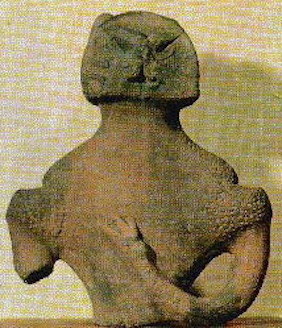 Fig. 6A17) Zooanthropomorphic ceramic sculpture representing an artistic man-animal hybrid. The head is a mixture of man and feline. The body is human and vertical, but is deliberately hideous in appearance. Other sculptures of man-animal hybrids of the Jomon period lead us to believe in a varied typology of artistic man-animal hybrids that surely had different religious meanings (see Fig.8A18 and Fig.8A20).
Fig. 6A17) Zooanthropomorphic ceramic sculpture representing an artistic man-animal hybrid. The head is a mixture of man and feline. The body is human and vertical, but is deliberately hideous in appearance. Other sculptures of man-animal hybrids of the Jomon period lead us to believe in a varied typology of artistic man-animal hybrids that surely had different religious meanings (see Fig.8A18 and Fig.8A20).
Size: small.
Origin: Japan.
Location: Tokyo National Museum.
NEXT
Index
HOME PAGE
Page translated from Italian into English by Paris Alexander Walker.
Copyright©2020 by Museum of the Origins of Man, all rights reserved.

















